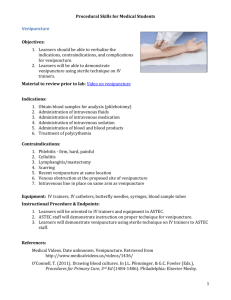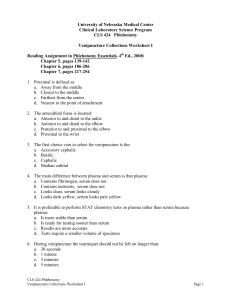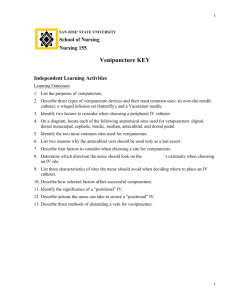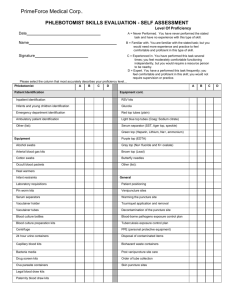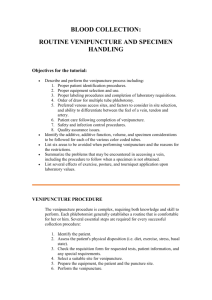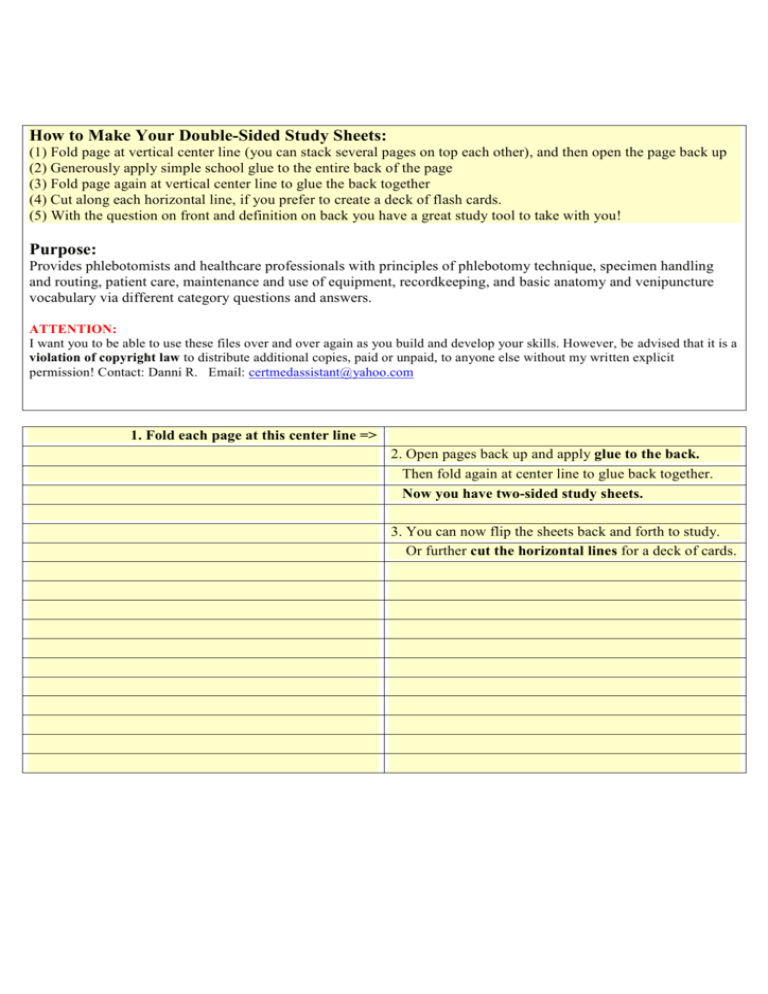
How to Make Your Double-Sided Study Sheets:
(1) Fold page at vertical center line (you can stack several pages on top each other), and then open the page back up
(2) Generously apply simple school glue to the entire back of the page
(3) Fold page again at vertical center line to glue the back together
(4) Cut along each horizontal line, if you prefer to create a deck of flash cards.
(5) With the question on front and definition on back you have a great study tool to take with you!
Purpose:
Provides phlebotomists and healthcare professionals with principles of phlebotomy technique, specimen handling
and routing, patient care, maintenance and use of equipment, recordkeeping, and basic anatomy and venipuncture
vocabulary via different category questions and answers.
ATTENTION:
I want you to be able to use these files over and over again as you build and develop your skills. However, be advised that it is a
violation of copyright law to distribute additional copies, paid or unpaid, to anyone else without my written explicit
permission! Contact: Danni R. Email: certmedassistant@yahoo.com
1. Fold each page at this center line =>
2. Open pages back up and apply glue to the back.
Then fold again at center line to glue back together.
Now you have two-sided study sheets.
3. You can now flip the sheets back and forth to study.
Or further cut the horizontal lines for a deck of cards.
Category: Order of Draw
Blood Cultures
Blood cultures MUST be drawn first to avoid bacterial
contamination
Category: Color of Stopper
Yellow (SPS)
Contains sodium polyanethol sulfonate. Used to collect
whole blood samples for blood culture specimens
Category: Color of Stopper:
Glass tube contains no additive--used for serum test(s)
that cannot be collected in SST tubes
Red “plain”
Plastic tube, although presumed to be a “non-additive”
tube, actually contains ultra-fine clotting agents!
Category: Color of Stopper
Light blue
Contains sodium citrate anticoagulant--used mainly in
coagulation studies
Category: Color of Stopper
Gold or Red/Gray “tiger top” (SST)
Contains a gel separator and clot activator--most
commonly used tube where serum is required
Category: Color of Stopper
Royal blue
Contains sodium heparin anticoagulant. This tube is
required for collection of trace elements
Category: Color of Stopper
Contains sodium heparin anticoagulant—for “plasma”
studies. Complete filling of the tube is necessary for
accurate results
Dark green
Category: Color of Stopper
Light green (mint) (PST) or green/gray mottled
Contains lithium heparin anticoagulant as well as a gel
separator
Category: Color of Stopper
Lavender
Category: Color of Stopper
Pale yellow (ACDA) or (ACDB)
Contains EDTA anticoagulant--used for hematology,
hemoglobin electrophoresis and hemoglobin A1c
ACDA: Contains acid citrate dextrose solution ‘A’.
Used primarily for flow cytometry testing
ACDB: Contains acid citrate dextrose solution ‘B’.
Used primarily for bone marrow donor registry
Category: Color of Stopper:
Black
Contains sodium citrate solution. Used to determine
ESR.
Color of Stopper:
Gray
“Glucose tube”. Contains sodium fluoride and potassium
oxalate anticoagulant--used primarily for lactate testing
Requisition Slip Preparation:
Patient name
Requisition Slip Preparation:
Confidential patient identification
Requisition Slip Preparation:
Patient gender & date of birth
Requisition Slip Preparation:
Date & time of collection
LAST name first followed by FIRST name and MIDDLE
initial
In special circumstances, to maintain a higher level of
confidentiality, patient identity may be protected by
using a code name/number instead of the patient’s name
Important information not to be overlooked, because
many reference ranges are determined by patient gender
and/or age
Date and time must be recorded at time of specimen
collection or completion of the requisition
Requisition Slip Preparation:
Specimen priority
Indicate specimen priority for each test--STAT means
immediately!
Requisition Slip Preparation:
Requisition must include name or initials of collector
Collector/Phlebotomist
Requisition Slip Preparation:
Indicate the name and location of the ordering physician
Referring physician
Requisition Slip Preparation:
Patient address and phone number
Patient address is not required for patients with a valid
patient ID number. Patient phone number is often
required on lab requisitions
Requisition Slip Preparation:
Copy to
Collection Sites:
Collection sites for blood specimens
Collection Sites:
Collecting blood from a vein with IV line
Collection Sites:
Patient with mastectomy
If additional copies of reports are required for other
physicians or facilities provide name and address!
(1) Antecubital area of the arm (2) Back of hand or side
of wrist (3) Foot or ankle only with written permission
of physician or nurse
Collect below an IV line or saline lock--IV must be
turned off by physician/nurse for a minimum of 3
minutes prior to collection
Phlebotomists will not collect from the arm or hand from
the side of a mastectomy
Collection Sites:
Collecting blood from limbs with indwelling artificial
access
Phlebotomists will not collect from limbs with
indwelling artificial access devices (other than IV/saline
lock)
Collection Sites:
Phlebotomists will not collect samples from
(anatomically -- where?)
Follow-up Procedure:
Patient refuses blood work
Priority Definition:
Routine
Phlebotomists will not collect from fistulas, shunts,
arterial lines, or heparin and saline locks
Notify the nursing unit personnel of the situation. Record
a written explanation, for example: "Patient refuses blood
work"
Analysis will be routinely performed -- result provided
within standard processing time
Priority Definition:
ASAP
Priority Definition:
Call Routine
Priority Definition:
Fax Routine
Transportation:
Packing specimens marked Frozen to be taken to
another location for testing
Analysis will be routinely performed -- tests will be
ordered as call/fax routine and will be communicated to
the referring physician
Routine tissue processing followed by result
communication by phone when available
Routine tissue processing followed by result
communication by fax when available
(1) DO NOT freeze specimens at the collection site on
weekdays unless otherwise noted (2) Store specimen in
refrigerator until courier pickup (as soon as possible!)
(3) Clearly mark “FREEZE” on the specimen container
Priority Definition:
Call STAT
Priority Definition:
Fax STAT
Transportation: Transportation of
refrigerated specimens to another location for
testing
Order of Draw:
How is the order of draw for multiple samples of
blood established?
Test is of critical nature -- the results must be available
from within 30 minutes to an hour of receipt of the
sample at the laboratory and be phoned to the ordering
physician’s office or other contact number as indicated
Test is of critical nature–test results must be available
from within 30 minutes to an hour of receipt of the
sample at the laboratory and be faxed to the ordering
physician’s office or other contact number as indicated
MUST be kept refrigerated before forwarding unless
otherwise indicated -- when ready to forward, enclose ice
pack to assist in maintaining temperature
When establishing an order of draw for blood collections,
one needs to look at the additives and the tests to be
collected
Order of Draw:
Citrate tubes (coag tubes)
Order of Draw:
Anticoagulants
Citrate tubes (coag tubes) should never be drawn alone or
as the first in the sequence of multiple draws -- Always
draw one other tube before the citrate to reduce
contamination by tissue fluids which could initiate the
clotting mechanism
Tubes with anticoagulants should be drawn last so that
they can be properly mixed as quickly as possible
Mixing:
It is essential that any tube with Anticoagulants is
inverted 6-8 times to mix the blood
Mixing collected blood with anticoagulants
Order of Draw:
According to the NCCLS standard H3-A5
1) Blood culture bottles and tubes
2) Citrate tubes (coagulation tests)
3) Serum tubes (red) with or without anticoagulants
4) Heparin tubes
5) EDTA
6) Oxalate/Fluoride tubes
Order of Draw: If blood is clotted in the syringe…
Site Preparation:
The FIRST STEP in preparing the puncture site
If blood is clotted in the syringe DO NOT force the blood
through the needle into the sample tube. Remove the
needle and the tube stopper; then deliver the blood to the
tube
The first step: decontaminate the area of the intended
puncture site
Site Preparation:
A prepackaged 70% isopropyl alcohol pad
The preferred antiseptic to prepare the puncture site
Site Preparation:
Alternative antiseptic to prepare the puncture site
Povidone-iodine (Betadine) may be used as an alternative
to alcohol
Site Preparation:
Povidone-iodine (Betadine)
Site Preparation:
What is the purpose for stabilizing the vein?
Order of Draw:
Microtainer collection method order of draw
Order of Draw:
Rationale behind the order of draw for evacuated
tubes
Used for blood cultures, bleeding times, and arterial
punctures
Pulling the skin taut keeps the vein from rolling and
reduces resistance allowing a cleaner entry of the needle
(1) Blood gases (2) Slides/smears (3) EDTA tubes (4)
Other additive tubes (5) Serum tubes
Following the recommended order of draw for blood
specimens is important for specimen integrity -- It
diminishes the possibility of cross contamination
between tubes due to the different additives present
Order of Draw:
Transferring blood from syringes to evacuated tubes
Order of Delivery:
Order of transferring collected blood from the
syringe to evacuated tubes
Order of Transfer:
Order of syringe transfer to evacuated tubes
Missed Draw:
Points to consider when a blood sample could not be
obtained
This method assumes that the blood in the last syringe is
the most "fresh" and will be the first syringe to transfer
its contents into a tube
Blood clotting starts the second the blood leaves the body
-- It is vital to fill the tubes with anticoagulants first, and
clot tubes last
(1) Sterile draw first (blood cultures) (2) Lavender First syringe transfer (3) Blue - Second syringe transfer
(4) Green - Third syringe transfer (5) Gray - Forth
syringe transfer (6) Red - Last syringe transfer
(1) Tube position and (lack of) vacuum (2) Needle
(bevel) position (3) Collapsed or rolling vein (4) Using
a vacuum tube when a syringe would have been more
appropriate (5) Using a butterfly with a vacuum tube
Missed Draw:
Recording a missed draw
Blood Collection Systems:
Evacuated tubes
Complete a "Missed Draw Form” stating the reason why
the blood could not be drawn -- One copy of the form is
placed in the patient's chart, and the other is filed in the
laboratory for supervisor review
Consists of a double headed needle, the needle holder,
and a color coded glass vacuum tube which may or may
not contain an additive
Blood Collection Systems:
Consists of a syringe and sterile needle
Syringe system
Blood Collection Systems:
Monovette system
A combination of the syringe principle and the Vacuum
technique developed by Sarstedt
Blood Collection Systems:
The blood lancet
Charting Procedure:
What should be recorded in patient’s chart?
A sharp blade which is designed to create a puncture -Comes in a variety of styles and point lengths
Chart procedure in the patients chart and record any
difficulties or complications during procedure
Requisition Slip Preparation:
What are the five most essential things to be included
on the requisition slip?
(1) Name (2) Place (3) Time (4) Date (5) Type of
specimen sent to lab
Microcollection:
What is one of the most commonly performed
procedures in clinical practice?
Blood glucose testing
Microcollection:
Other terms for microcollection: (name them!)
(1) Microsampling (2) Capillary puncture (3) Heel
stick (4) Finger stick
Microcollection:
In a “finger stick” which finger is usually the finger of
choice?
Microcollection:
Why should swollen or edematous areas not be used?
Middle finger
Swollen or edematous areas should not be used because
of possible contamination with tissue fluids
Microcollection:
Why is microcollection the collection method of
choice for newborn infants?
Newborns have little blood volume It is very dangerous
to remove too large an amount of blood
Microcollection:
What is the site of choice to collect a blood sample
from neonates?
Microcollection:
Microcollection may be the procedure of choice for
the following adults: (name them!)
In neonates, the blood is generally obtained from the heel
(1) Severely burned (2) Obese patients (3) Patient with
thrombotic tendencies (4) Patient with very poor veins
(5) Geriatric patients (6) Patient is extremely
apprehensive (7) Patient’s vein is to be saved for another
procedure
Microcollection:
Babies should never be stuck with a puncture device
that exceeds ___ millimeter(s)
Microcollection:
What is an automatic puncture device?
two millimeters (2 mm)
Automatic puncture devices are spring loaded lancets,
such as the Autolet
Microcollection:
What is a Unopette™?
The Unopette is a system composed of a micropipette
and dilution system
Microcollection:
Used to prepare dilutions of the blood sample
What is a Unopette used for?
Microcollection:
What should never be put on the puncture site of an
infant or very small child after the blood is drawn?
Band aid or adhesive tape
Microcollection:
To stimulate adequate blood flow from the puncture
site, do what to the area for 1 to 2 minutes?
massage
Microcollection:
Why must tissue fluids in the blood sample be
avoided?
Normal values:
What exactly does the hematocrit reading show?
Tissue fluids contain coagulation factors that can
accelerate clumping of the blood making the sample
unacceptable for testing
What per cent of the blood is plasma and what per cent
are RBC
Normal values
45 - 50%
Normal hematocrit values for a newborn?
Normal values:
27 - 44%
Normal hematocrit values for a one year old ?
Normal values:
36 - 48%
Normal hematocrit values for a woman?
Normal values:
40 - 55%
Normal hematocrit values for a man?
Microcollection:
The microhematocrit test
What test is done to determine if a patient is anemic?
Blood Sample Preparation:
Centrifugation causes the blood to separate into three
distinct layers: (name them!)
(1) Plasma (2) Buffy coat (3) Red blood cells
Blood Sample Preparation:
What are dilutions of blood samples prepared with
the Unopette used for?
(1) WBC counts (2) Platelet counts (3) Hemoglobin
determinations (4) RBC counts
Blood Sample Preparation:
What is the name of the machine which spins the
tubes around at a great rate of speed?
Centrifuge
Venipuncture Equipment:
What size (gauge) of a needle is used to collect from a
vein from the wrist, back of hand, or ankle?
25 G
Venipuncture Equipment:
What size (gauge) of a needle is used to collect from
children?
25 G
Venipuncture Equipment:
Red top
Color (top) of the plain tube
Venipuncture Equipment:
Blue top
Color (top) of citrate (coagulation) tube?
Venipuncture Equipment:
Black top
Color (top) of ESR tube?
Venipuncture Equipment:
Green top
Color (top) of heparinized tube?
Venipuncture Equipment:
Purple top
Color (top) of EDTA (blood count) tube?
Venipuncture Equipment:
Gray top
Color (top) of fluoride tube?
Venipuncture Equipment:
Yellow top
Color (top) of CPD tube?
Venipuncture Equipment:
Zinc, copper, and aluminium
What elements is a trace metal tube used for?
Venipuncture Equipment:
ESR tube
What is another name for thin, black top tube?
Blood Sample Preparation:
What is one major culprit of cross contamination
between Vacutainer™ tubes?
Blood Collection Tubes:
Red Top Glass Tubes
Cross contamination can occur between the contents of
Vacutainer™ tubes when taking multiple samples
Chemistry and viral antibody testing. No anticoagulant
is contained in the tube
Blood Collection Tubes:
Certain blood bank testing, chemistries and drug levels
Red Top Tubes (Non-Barrier)
Blood Collection Tubes:
Coagulation testing
Light Blue Top Tube
Blood Collection Tubes:
Lavender Top Tube (EDTA)
Hematology, chemistry, blood bank, and virology
testing
Blood Collection Tubes:
HCG’s and other routine chemistry tests
Light green Top Tube (PST)
Blood Collection Tubes:
Hematology, chemistry, and virology testing
Green Top Tube
Blood Collection Tubes:
Cytogenetic testing and other specialty tests
Brown Top Tube
Blood Collection Tubes:
Sedimentation (SED) rates
Black Top Tube (ESR)
Blood Collection Tubes:
Certain chemistry testing
Gray Top Tube
Blood Collection Tubes:
Certain reference tests requiring whole blood
Yellow Top Tubes
Blood Collection Tubes:
Certain reference tests
Navy Blue Top Tube (No Additive)
Blood Collection Tubes:
Certain reference tests
Navy Blue Top Tube (EDTA)
Microbiology/Virology Collection Kits:
Gen-Probe Collection Kits
For the collection of GC and Chlamydia -- Male and
female kits are available from the Microbiology
Laboratory
Microbiology/Virology Collection Kits:
Aerobic and anaerobic bottles are available
Blood Culture Bottles (Oragon Teknika Bact/Alert)
Microbiology/Virology Collection Kits:
Isolator Tubes
Microbiology/Virology Collection Kits:
Swab/Culturette™
Used for the isolation of mycobacteria, fungal organisms,
fastidious aerobic organisms as well as for the removal of
antibiotics from cultured blood
Sterile dacron swabs with ampule of holding medium -Used for all aerobic cultures
Microbiology/Virology Collection Kits:
Used for anaerobic cultures
Anaerobic Transport Media
Microbiology/Virology Collection Kits:
Viral Transport Media
Used for viral isolation for HSV, CMV, varicella, and
adenovirus
Venipuncture Equipment:
What is unique about the needle that is used with a
needle holder and Vacutainers™ tubes?
(1) It is pointed at both ends (2) The short end is
covered with a rubber sheath (3) it is a multi-draw
needle
Venipuncture Equipment:
Vacutainer™ needle lengths range from 1 to 1 ½ inches
How long is the long end of the Vacutainer™ needle?
Venipuncture Equipment:
When would you use the longer 1 ½ inch
Vacutainer™ needle?
Venipuncture Equipment:
What is the “gauge” of a needle?
1 ½ inch Vacutainer™ needles are used for patients with
very deep veins
The gauge of a needle is a number that indicates the
diameter of its lumen
Venipuncture Equipment:
What is the “lumen” of a needle?
The lumen, also called the bore, is the circular hollow
space inside the needle
Venipuncture Equipment:
What are the most frequently used gauges for
phlebotomy?
20 , 21 , and 22 G
Venipuncture Equipment:
The slanted opening at the end of the needle
What is the “bevel” of a needle?
Venipuncture Equipment:
Inside an evacuated tube, what is the air pressure
compared to the outside environment?
The air pressure inside the tube is negative, less than the
normal environment
Venipuncture Equipment:
What sizes are the needle holders for evacuated
tubes?
Venipuncture Vocabulary:
Anerobic
Holders are available in two sizes, either for adults or for
pediatric procedures
Growing, living or occurring in the absence of molecular
oxygen; pertaining to an anaerobe
Venipuncture Vocabulary:
That part of the arm opposing the elbow
Antecubital
Venipuncture Vocabulary:
Anticoagulants
Anticoagulant solutions are used for the preservation of
stored whole blood and blood fractions; to prevent
clotting for laboratory analysis
Venipuncture Vocabulary:
Antiseptic
Something that discourages the growth microorganisms - By contrast, aseptic refers to the absence of
microorganisms
Venipuncture Vocabulary:
Refers to the absence of microorganisms
Aseptic
Venipuncture Vocabulary:
Arterial blood
Venipuncture Vocabulary:
Aspirate
Blood contained within the arteries -- Carries oxygen
from the heart and lungs to outlying organs and tissues
The material that is withdrawn with a negative pressure
apparatus (syringe)
Venipuncture Vocabulary:
Basilic vein
Large vein on the inner side of the biceps -- Often chosen
for intravenous injections and blood drawing
Venipuncture Vocabulary: Betadine™
A popular trade name iodine-containing topical antiseptic
agent; povidone-iodine
Venipuncture Vocabulary: Blind stick
Performing a venipuncture with no apparently visible or
palpable vein by a highly skilled phlebotomist
Venipuncture Vocabulary: Blood
The fluid in the body that contains red cells and white
cells as well as platelets, proteins, plasma and other
elements
Venipuncture Vocabulary: Blood cell
There are three main types of cells in the blood stream:
(1 ) red cell (2) platelet (3) white cell
Venipuncture Vocabulary: Blood clot
The conversion of blood from a liquid form to solid
through the process of coagulation
Venipuncture Vocabulary: Blood culture
A test which involves the incubation of a blood
specimen over a certain time to determine if bacteria are
present
Venipuncture Vocabulary: Bloodborne pathogens
Pathogens which are present in the blood stream and
which may be passed to others
Venipuncture Vocabulary: Butterfly
A small needle with two plastic wings attached which
are squeezed together to form a tab that is used to
manipulate the needle
Venipuncture Vocabulary: Centrifuge
A laboratory apparatus that separates mixed samples into
homogenous component layers by spinning them at high
speed
Venipuncture Vocabulary: Circulation
The movement of fluid in a regular or circuitous course
Venipuncture Vocabulary: Citrate
Citrate chelates (chelate means bind) calcium ions,
preventing blood clotting
Venipuncture Vocabulary: Clot
A semisolid mass of blood found inside or outside the
body
Venipuncture Vocabulary: Coagulation
The process of clot formation
Venipuncture Vocabulary: Coagulation Factors
Group of plasma protein substances (Factor I-XIII)
contained in the plasma, which act together to bring
about blood coagulation
Venipuncture Vocabulary: Complete blood count CBC
The number of red blood cells, white blood cells, and
platelets (per cubic millimeter) -- Also included is the
hematocrit (%), hemoglobin concentration (gm%) and
the differential
Venipuncture Vocabulary: Contamination
The soiling or pollution by inferior material, as by the
introduction of organisms into a wound
Venipuncture Vocabulary: Diaphoretic
Formation of profuse perspiration (sweat) -- A symptom
of syncope
Venipuncture Vocabulary: Differential
A count made on a stained blood smear of the proportion
of the different leukocytes (WBC's) and expressed as a
percentage -- A normal part of a complete blood count
(CBC)
Venipuncture Vocabulary: Ecchimosis
The skin discoloration caused by a bruise (contusion)
Venipuncture Vocabulary: Edema
The swelling of soft tissues as a result of excess water
accumulation
Venipuncture Vocabulary: EDTA
Ethylenediaminetetraacetate, calcium chelating
(binding) agent
Venipuncture Vocabulary: Electrolyte
A substance that will acquire the capacity to conduct
electricity when put into solution
Venipuncture Vocabulary: Embolus
A sudden blockage of a blood vessel by a blood clot or
some other and is lodged at a site too small for passage
Venipuncture Vocabulary: Erythrocyte
Cells that carry oxygen to all parts of the body
Venipuncture Vocabulary: Factor VIII
One of a number of coagulation factors; deficiency
causes classic hemophilia
Venipuncture Vocabulary: Fasting
Without eating
Venipuncture Vocabulary: Fibrin
The protein formed during normal blood clotting that is
the essence of the clot
Venipuncture Vocabulary: Fibrinogen
The protein from which fibrin is formed or generated in
normal blood clotting
Venipuncture Vocabulary: Flash-back
The appearance of a small amount of blood in the neck
of a syringe or the tubing of a butterfly
Venipuncture Vocabulary: Gauge
Needle diameter is measured by gauge; the larger the
needle diameter, the smaller the gauge
Venipuncture Vocabulary: Germicide
An agent that kills pathogenic microorganisms
Venipuncture Vocabulary: Glucose
The sugar measured in blood and urine specimens to
determine the presence or absence of diabetes
Venipuncture Vocabulary: Heparin
An anticoagulant that acts to inhibit a number of
coagulation factors, especially factor Xa
Venipuncture Vocabulary: Hematocrit
The ratio of the total red blood cell volume to the total
blood volume and expressed as a percentage
Venipuncture Vocabulary: Hematoma
A localized collection of blood within tissue due to
leakage from the wall of a blood vessel
Venipuncture Vocabulary: Hemoconcentration
A decrease in the fluid content of the blood (plasma),
resulting in an increase in concentration
Venipuncture Vocabulary:
The oxygen carrying pigment of the red blood cells
Hematocrit
Venipuncture Vocabulary:
Hemolyze
Venipuncture Vocabulary:
Hypodermic needle
The breaking of the red blood cells membrane releasing
free hemoglobin into the blood
A needle that attaches to a syringe for the purpose of
injections or withdrawal of fluids such as blood
Venipuncture Vocabulary:
Multi-sample adapter
Venipuncture Vocabulary:
Order of delivery
Venipuncture Vocabulary:
Order of draw
Venipuncture Vocabulary:
Oxyhemoglobin
A device used with a butterfly and Vacutainer™ holder
to allow for the withdrawal of multiple tubes of blood
during a venipuncture
A term used to define the order in which tubes should be
filled with blood after being drawn by syringe
Defines the order in which blood sample tubes should be
drawn
Hemoglobin that has been bound with oxygen in the
lungs
Venipuncture Vocabulary:
Palpate
To examine or feel by the hand In relation to
venipuncture, this technique is used to "feel" a vein
Venipuncture Vocabulary:
Any microorganism that produces disease
Pathogen
Venipuncture Vocabulary:
Having the capability of producing disease
Pathogenic
Venipuncture Vocabulary:
Pipet
A glass or transparent plastic tube used to accurately
measure small amounts of liquid
Venipuncture Vocabulary:
Plasma
Venipuncture Vocabulary:
Peripheral blood
Venipuncture Vocabulary:
Platelet
Venipuncture Vocabulary:
Red blood cells (RBC)
The fluid portion of the blood in which the cellular
components are suspended
Blood obtained from the circulation away from the heart,
such as from the fingertip, heel pad, and earlobe, or from
an antecubital vein
Also known as a thrombocyte, this is a particulate
component of the blood, involved in blood coagulation
One of the solid components of the blood which is
normally a biconcave disc without a nucleus
Venipuncture Vocabulary:
Sclerosis
Venipuncture Vocabulary:
Serum
Venipuncture Vocabulary:
Tourniquet
Venipuncture Vocabulary:
Vacutainer™
A hardening; especially from inflammation and certain
disease states
Referring to blood, the clear liquid portion of blood that
separates out after clotting has taken place -- Since
clotting has occurred, serum is fibrinogen deficient
Contrast to plasma
A constrictive band, placed over an extremity to distend
veins for the purpose of blood aspiration
An often generic term used to describe equipment used to
automatically aspirate blood from a vessel by
venipuncture
Venipuncture Vocabulary:
Blood sample tubes containing a vacuum
Evacuated tube or Vacutainer™ tube
Venipuncture Vocabulary:
Blood vessels carrying blood to the heart
Vein
Venipuncture Vocabulary:
The puncture of a vein for any purpose
Venipuncture
Venipuncture Vocabulary:
Blood contained within the veins
Venous blood
Venipuncture Vocabulary:
Warfarin sodium
Venipuncture Vocabulary:
White blood cell (WBC)
Venipuncture Vocabulary:
White cell count
Venipuncture Vocabulary:
Whole blood
The sodium salt of warfarin, one of the synthetic
coumarin anticoagulants Coumadin™
Also leukocyte -- A variety of cells within the blood and
bone marrow whose general purpose is to help in fighting
infection
The number of white blood cells (leukocytes) found in
the peripheral blood and measured per cubic millimeter
Blood from which none of the elements have been
removed
Blood Sample Preparation:
When mixing how many turns of a tube equals one
inversion?
These flash cards/study sheets rely heavily on the Microsoft Office program to be viewed, edited, and printed. As such, it is
extremely difficult to protect this information from duplication.
ATTENTION:
I want you to be able to use these files over and over again as you build and develop your skills. However, be advised that it is
illegal and a violation of copyright law to distribute additional copies, paid or unpaid, to anyone else without my written
explicit permission!
Contact: Danni R. Email: certmedassistant@yahoo.com
©2003-2007 Advanced Medical Assistant Custom Web Design, LLC. All rights reserved

